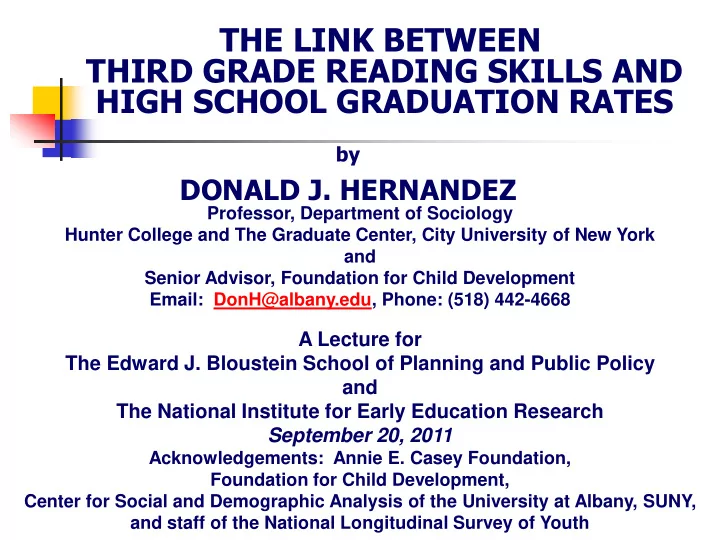

THE LINK BETWEEN THIRD GRADE READING SKILLS AND HIGH SCHOOL GRADUATION RATES by DONALD J. HERNANDEZ Professor, Department of Sociology Hunter College and The Graduate Center, City University of New York and Senior Advisor, Foundation for Child Development Email: DonH@albany.edu, Phone: (518) 442-4668 A Lecture for The Edward J. Bloustein School of Planning and Public Policy and The National Institute for Early Education Research September 20, 2011 Acknowledgements: Annie E. Casey Foundation, Foundation for Child Development, Center for Social and Demographic Analysis of the University at Albany, SUNY, and staff of the National Longitudinal Survey of Youth
Slide 2. Thanks for Support and Assistance Thanks for support from… ● Annie E. Casey Foundation ● Foundation for Child Development and assistance from… ● Center for Social and Demographic Analysis, University at Albany, SUNY ● Staff of the National Longitudinal Survey of Youth
Slide 3. Overview of New Study ● Why study third-grade reading? ● Key features of the study ● New findings ● Policies and programs ● Future research plans and possibilities ● Focusing on the Children of New Jersey
Slide 4. Why Focus on Third Grade Reading Skills? Third grade marks the point when students shifts from “LEARNING TO READ” To “READING TO LEARN”
Slide 5. Why Focus on Third-Grade Reading Skills? No Child Left Behind Act …asserted “President Bush’s unequivocal commitment to ensuring that every child can read by the end of third grade” …requires states to annually test and report third-grade reading skill by poverty status and race-ethnicity
Slide 6. Why Focus on Third-Grade Reading Skills? President Obama’s blueprint for the Elementary and Secondary Education Act calls for… “Putting Reading First” by significantly increasing Federal investment in scientifically-based early-reading instruction
Slide 7. New Results in This Study First-ever study to calculate high school graduation rates for children with different… reading skill levels and poverty experiences and for specific race-ethnic groups
Slide 8. Fourth-Grade Reading Skills of America’s Children, Based on NAEP, “The Nation’s Report Card” Among All children… ● 33% … proficient readers (at or above grade level) ● 67% ... not-proficient readers (below grade level) Among Not Proficient Readers… ● 33% … basic level readers ● 34% … below -basic level readers
Slide 9. Key Features of the New Study ● 1/3 of children classified as high, medium, or low skill readers ● National Longitudinal Study of Youth ● 3,975 children born 1979-1989 ● PIAT reading test ● Children classified as (1) never poor, or (2) poor at least 1 of 5 interview years ● High school graduation on time, that is, by age 19
Slide 10. Percent of Students Not Graduating by 3 rd Grade Reading Proficiency 16% 12% 12% 4% 4% Total Profic icient ient Not Profic icien ient, t, Total
Slide 11. Percent of Students Not Graduating, among Not-Proficient Readers 23% 23% 16% 9% 9% No Not Proficie icient, nt, No Not Proficie icient, nt, Not Proficie No icient, nt, Total al Basic ic Below w Basic ic
Slide 12. 3 rd Grade Reading Test Scores for All Students and Non-Graduates Reading Scores for Reading Scores for All Students Non-Graduates 12%: %: High, h, Prof oficien icient 33.3%: .3%: 33.3%: .3%: Low, , Not ot High, h, Prof oficien icient t 25%: %: Prof oficien icient Belo low w 63%: %: Low, Medium, dium, Basic sic Not ot Not ot Prof oficien icient t Prof oficien icient t Belo low w Basic sic Basic sic 33.3%: .3%: Medium dium, Not ot Prof oficien icient t Basic sic
Slide 13. Percent of Students Not Graduating by Reading Proficiency & Poverty Experience
Slide 14. Poverty Experience for All Students and Non-Graduates Poverty Experience for Poverty Experience for All Students Non-Graduates No No Yes 30% 30% 38% 38% No No Yes 62% 62% 70% 70%
Slide 15. Percent of Students Not Graduating by Reading Proficiency & Race-Ethnicity
Slide 15. Race-Ethnicity of All Students and Non-Graduates Race-Ethnicity of Race-Ethnicity of Non-Graduates All Students
Slide 17. Percent Not Graduating from High School across Reading, Poverty, and Race-Ethnic Groups 33% 31% 26% 22% Total 16% White Black 4% Hispanics Total Some Poverty Proficient Not Proficient
Slide 18. Percent Not Graduating from High School across Selected Reading and Poverty Groups 11% Total White 9% Black Hispanics 5% 3% 2% 2% No Poverty Poverty No Poverty Proficient Not Proficient
Slide 19. Government Policies to Improve Third-Grade Reading and High School Graduation ● Align high quality early education with curriculum/standards thru 3 rd grade ● Attend to health and developmental needs of children ● Work training and other programs to help lift families out of poverty ● Dual-Generation programs
Slide 20. Future Analyses to Provide Deeper Understanding ● How much difference does living in a poor neighborhood make? ● What kinds of resources for families foster children’s school success? ● What family processes link these resources… …… to better third -grade reading? and …… to high school graduation?
Recommend
More recommend